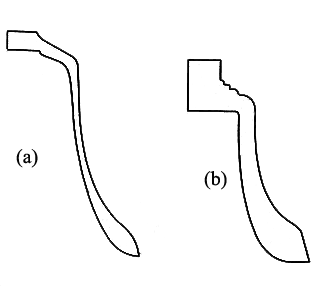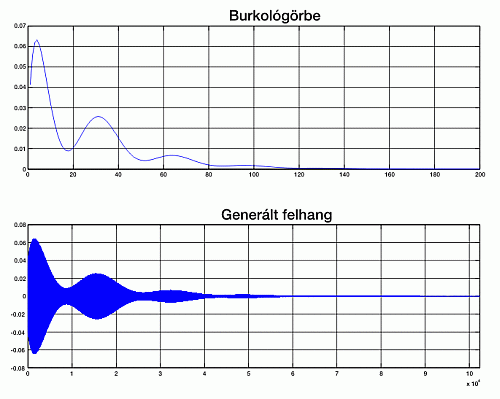|
Sound Synthesis of Bells
Bells are very expensive devices, because of the expensive raw
materials, complex technology, and the low production quantity. Since the
molding is inaccurate, the bells' sounds are inaccurate, too. Correction is very
difficult, and - especially in the case of large bells - almost impossible.
The development of the digital technology in the last decade
made it possible to generate bell sounds electronically - at much less expense.
There are different methods available in the literature for bell sound
synthesis, however, the choice is not obvious. Our aim was the development of a
synthesizer, which satisfies the following requirements:
- the pitch of the sound and the quality of the strike is easy to change;
- It is easy to analyze and synthesize new bells;
- The algorithm can be implemented on signal processors.
We were looking for solution satisfying the above requirements.
We have developed a special synthesis, which can generate reasonable bell
sound.
Physical Description of the Bell
Fig. 1. shows two typical bell profiles. Fig. 1.a shows a
section of a bell for churches, while the profile in Fig. 1.b is for chimes.
Profiles are different at each foundry, since they have developed their bell
sets independently from each other. The knowledge comes down from generation to
generation and it is a hard secret. The bell is made from a special alloy, which
is a kind of brass. The composition is the following: copper - 80%, tin - 18%,
the rest is zinc and lead.
 |
|
Fig. 1. Bell profiles for churches (a) and for chimes (b)
|
The vibration of the bell is very complicated. Theoretically
the motion can be described as linear combination of modes which are
perpendicular to each other, where the initial amplitudes are determined by the
strike. According to theoretical derivations it can be predicted that each mode
has 2m radial, uniformly spaced, and n parallel nodes, where
m, n = 0, 1, 2, ... . If m = 0, the modes are single ones,
while if m > 0, there are mode pairs. The latter ones - if the bell's
cross-section is really a circle - form one partial. However, in the practice
the bells are not symmetric, therefore these pairs form two partials, which
sound as tremolo, because of the small frequency deviation. Fig. 2. shows the
first five modes, where the dashed lines denote the nodes. Table 1. summarizes
the most important partials and their tuning.
 |
|
Fig. 2. The first five modes
|
|
Mode |
Overtone |
Ideal |
Tempered |
|
(2,0) |
Hum |
0.500 |
0.500 |
|
(2,1#) |
Prime |
1.000 |
1.000 |
|
(3,1) |
Tierce |
1.200 |
1.183 |
|
(3,1#) |
Quint |
1.500 |
1.506 |
|
(4,1) |
Nominal |
2.000 |
2.000 |
|
(4,1#) |
Decima |
2.500 |
2.514 |
|
(2,2) |
Undecima |
2.667 |
2.662 |
|
(5,1) |
Doudecima |
3.000 |
3.011 |
|
(6,1) |
Upper octave |
4.000 |
4.166 |
|
(7,1) |
Upper undecima |
5.333 |
5.433 |
|
(8,1) |
|
6.667 |
6.796 |
|
(9,1) |
Tripple octave |
8.000 |
8.215 |
|
Table 1. The most important partials and their tuning
|
The Bell Model
Since the vibration of the bell can be described by modes, it
is straightforward to attempt the modeling the bell sound by resonators. By
changing the inputs of the resonators, different effects can be performed.
During laboratory investigations we have detected more than 140 modes. Such a
high number of modes cannot be calculated in real-time, therefore the question
was the following: how many partials are enough to implement for a realistic
bell sound? Further investigations have shown that 10-15 partials are usually
enough. For the calculation of the resonators the following parameters are to be
known:
- goodness factor;
- angular frequency;
- initial amplitude;
- initial phase.
These parameters can be determined by Dirac-delta like
excitation of the bell (striking with high speed with a hard hammer). The
angular frequencies are known from the spectrum, and the other parameters can be
calculated from the envelopes of the individual partials. The envelopes can be
derived by mixing each partial to DC:
The envelope can be modeled by a low-order IIR filter, which
can be approximated using the Steiglitz-McBride algorithm. (In order to decrease
the computational demand, the envelope is decimated.) Poles and zeros can be
calculated from the z-domain transfer function of the IIR filter. Each pole-zero
system generates a certain impulse response with specific initial amplitude and
exponential decay. In order to get the right IIR structure which generates
already the partial itself, the poles are to be transformed in two steps:
- elongation: according to the rate of the decimation, the pole should be
shifted toward the unit circle;
- rotation: according to the frequency of the partial, the pole should be
rotated round the origin. Since in general the poles do not form conjugate
complex pairs, the resonators are complex.
The transfer function of the complex resonators:
The impulse response of the system:
where  , ,
which is an exponentially decaying sinusoidal with an angular
frequency of , while , while 
determines the initial amplitude and phase:  . In this case the real and imaginary parts of
the complex resonator are: . In this case the real and imaginary parts of
the complex resonator are: 
The difference between the frequency, initial phase and
amplitude of the complex resonators results that the sum of them can model the
envelopes. Fig. 3. shows an envelope and the corresponding partial. The sound of
the bell is generated by the parallel connection of the partials, that is the
parallel connection of the complex resonators.
 |
|
Fig. 3. The envelope and the corresponding partial
|
The Hammer Model
It is supposed that the measured bell sounds are results of
Dirac-delta like excitation. Hammer model should manage the following
parameters:
- strength of the strike;
- nature of the hammer material.
The measurements in the Digital Signal Processing Laboratory
can be concluded as follows:
- The hardness of the hammer is proportional to the bandwidth of the force
signal. It means that striking with soft materials (rubber, wood) results in
smaller bandwidth;
- The strength of the strike is proportional to the peak of the force
signal;
- The strength of the strike is proportional to the bandwidth of the force
signal, that is stronger strike results in larger bandwidth.
Fig. 4. shows the measurement of a bell. The force of the
strike is measured by a force transducer attached to the hammer, while the sound
is measured by a microphone. Both signals are recorded and processed
off-line.
The requirements for the hammer model can be satisfied by a
simple first-order IIR filter, which can be tuned according to the strength of
the strike and the material of the hammer. This solution is also optimal for
real-time implementation. The filter is excited by a single impulse, the
amplitude of which is proportional to the force, the output of the filter is
lead to the input of the resonators.
 |
|
Fig. 4. Measurement of the bell of the reformed church of Õcsény in the
DSP Lab |
Summary
Although the research is not completely finished, our present
model produces very realistic sound. The survey of the literature and our own
investigations have shown that a physically informed (pseudo-physical) synthesis
results in a competitive bell model. This model can be efficiently implemented
with high sound quality on signal processors available in 2006, like ADSP 21262,
300 MHz. The bell synthesizer can be listened e.g. at Gárdonyi Géza Primary
School in Budapest, or at the church in Gödöllő-Máriabesnyő.
Sound Examples
The mp3 file is recorder from a real-time synthesiser
applying a DSP.
Related Publication:
|
Lajos Rancz, Sound synthesis of
bells (in Hungarian), M.Sc. thesis, Budapest
University of Technology and Economis, 2004. |
Detailed description of the sound synthesis method
|
Useful Link:
Further information: László Sujbert, Lajos Rancz
|